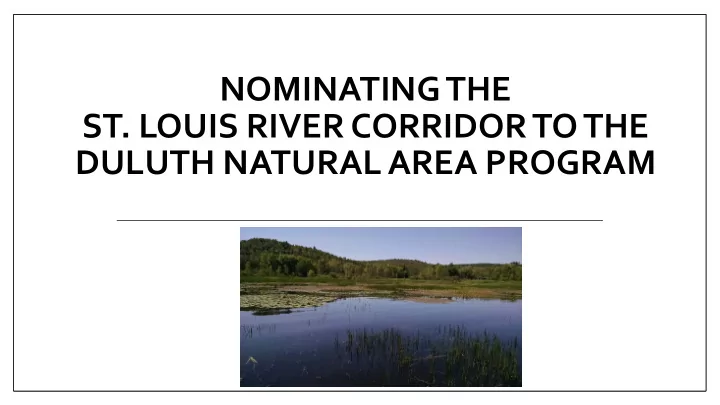

NOMINATING THE ST. LOUIS RIVER CORRIDOR TO THE DULUTH NATURAL AREA PROGRAM
Governing Principles for Open Space Duluth’s Comprehensive Plan – updated 2018 • Declare the necessity and secure the future of undeveloped places • Reinforce the place- specific • Take sustainable actions • Develop a healthy community
Policies related to Open Space • Improve resiliency to flooding and natural disasters • Examine the value and need for publicly owned open space • Review public lands and prioritize according to ecological importance vs other uses • Encourage the use of the Duluth Natural Areas Program to more permanently protect ecosystems over human use
Ordinance - Duluth Natural Areas Program Legislative Code, Chapter 2, Article XXIX, Sec. 2-152 The ability to nominate certain lands with environmental value as permanent open space. In doing so, we are preserving our natural heritage for the public good by: • Protecting landscapes of environmental significance and ensuring better management our forests, streams and wetlands • Supporting diversification of our region’s economy • Promoting the well-being and happiness of our citizens and visitors • Maximizing for resiliency in a changing climate through services these lands provide • Magney-Snively (2003) Hartley (2018)
St. Louis River corridor initiative St Louis River Western Waterfront Trail St. Louis River Natural Area National Water Trail Extension Plan (designation pending)
9 Project Areas of Ecological Significance Number Ownership of Parcels Area (%) City of Duluth 88 32 Private 45 36 St. Louis County 139 27 Tax-Forfeit State Public 2 5 Property Total 274 100
The Case for a St. Louis River Natural Area Duluth Natural Area Survey and Data Findings Criteria Significant native plant 17 distinct (e.g., Lake Superior estuary communities marsh) Special species 3 plants; 52 birds Important bird Thousands of birds migrating and congregation areas nesting 4 state designated trout streams and the Natural water features estuary Backwater bays indicative of ancient Geologic landforms drowned river mouths that once flowed into Glacial Lake Duluth.
Summary of Plant Communities Percent of Project Community Grouping Description Areas Dominated by aspen, basswood, birch, white cedar, Forested Upland 30.4% and oak Shallow water table, dominated by ash, balsam Forested Wetland 11.7% poplar, and white cedar Shrub and Shallow water table to inundation with surface water, 42% Open Wetland water-loving shrubs / herbaceous plants Cliffs and talus slopes and rocky shorelines, patchy Sparse-Vegetated Upland 0.7% trees and shrubs
Native Plant Communities • Identified 17 distinct native plant communities • Noted for Estuary Marsh (Lake Superior) - MRu94a • more species-diversity than similar native marsh communities in inland settings • Estuary below the dam contains the largest area of this community in the state • 120 acres within proposed natural area
Native Plant Community Condition Ranks Condition Description Area (%) Rank A Excellent ecological integrity. Little disturbed by recent human 7 activity or invasive species. A/B 2 B Good ecological integrity. Lightly disturbed or recovered from past 54 disturbance. Can return to A-rank with protection or management. B/C 1 C Fair ecological integrity. Strong evidence of human disturbance, 33 but retain some characteristic species. C/D 2 D Poor ecological integrity. Severely altered by human disturbance or 1 invasive species.
Kingsbury Bay Condition Rank • Identifies restoration opportunities • Native plant communities are the restoration targets
Special Plant Species • Two state species of concern • Chambers Grove • Munger Landing • Grassy Point • Rask Bay • One state endangered species • Grassy Point
Bird Surveys • Spring migration • Breeding season • Fall migration American Bittern photo credit: Steve Kolbe • 14 surveys conducted in each of the nine project areas • Total of 169 species and 13,953 individuals documented Spotted Sandpiper photo credit: Steve Kolbe
Birds of Note 52 species of state, regional, or federal concern were observed, including state threatened Common Tern, Horned Grebe, Trumpeter Swan, Peregrine Falcon Rust Blackbird photo credit: Cornell Ornithology • Rusty Blackbird , observed in spring and fall migration surveys, has undergone one of the sharpest and most mystifying recent declines of any North American songbird • Red-shouldered Hawk has been observed at Hawk Ridge less than eight times in the last 21 years. • Peregrine Falcon and Bald Eagle are regularly observed breeding in the estuary
Bird Survey Results DNAP Guild Description Criteria Met Waterfowl Highly adapted to living on the surface of the water. Shorebirds Wet or coastal environments; most species commonly found wading along shorelines while foraging for food in mud or sand. Waterbirds On or around water; special adaptations such as webbed feet, bills and legs adapted to feed in water; ability to dive from the surface or the air to catch prey in water. Not well Raptors “Birds of Prey”; primarily hunt and feed on vertebrates. assessed by survey methods Wading Wading birds while foraging. Birds Migratory Refers largely to passerines or perching birds. Landbirds
Important Bird Congregation Areas
Natural Water Features
Geologic Features
Development Suitability at Project Areas Grassy Point Kingsbury Tallus Island Munger Landing Chambers Grove Mud Lake Radio Tower Bay Rask Bay North Bay
St. Louis River Natural Area would not: Restrict the freedom of motorized and non- motorized boats to travel and fish throughout the estuary Place additional limits on private development Require any property owner to sell
St. Louis River Natural Area would: Lead to development and implementation of a restoration, protection, and management plan for the natural area. Improve access to grant dollars Assure that park and trail plans are consistent with environmental conservation goals
Nomination of the Proposed St. Louis River Natural Area Public Process Date Stakeholder meeting February 27 Park and Recreation March 13 (Informational) Planning Commission May 14 City Council May 28
Recommend
More recommend